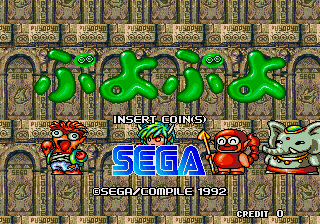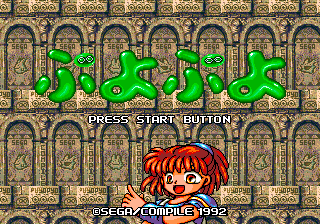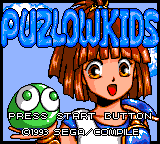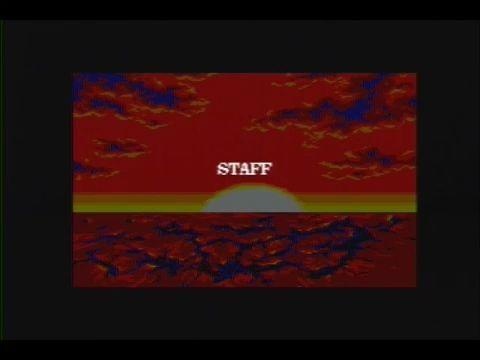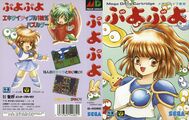Difference between revisions of "Puyo Puyo"
From Sega Retro
m (Text replacement - "\| (.*)_source={{num\|([0-9][0-9][0-9][0-9]-[0-9][0-9])\|page=(.*)\|pdf=(.*)\|pdfpage=(.*)}}" to "| $1_source={{magref|$1|$2|$5|printpage=$3}}") |
Hyperspeed34 (talk | contribs) |
||
| (42 intermediate revisions by 16 users not shown) | |||
| Line 1: | Line 1: | ||
| − | + | {{OtherPage|desc=the International Mega Drive version|page=Dr. Robotnik's Mean Bean Machine|desc2=the International [[Sega Master System]] and [[Sega Game Gear]] versions|page2=Dr. Robotnik's Mean Bean Machine (8-bit)}} | |
| − | + | {{OtherPage|desc=the mobile port|page=Puyo Puyo (mobile)}} | |
{{Bob | {{Bob | ||
| − | | bobscreen= | + | | bobscreen=PuyoPuyo SystemC2 EN Title.png |
| − | | publisher=[[Sega]] | + | | bobscreen2=PuyoPuyo SystemC2TitleScreen.png |
| − | | developer=[[Compile]], [[Sega AM1]] | + | | bobscreen3=PuyoPuyo MDTitleScreen.png |
| − | | system=[[Sega System | + | | bobscreen4=PuyoPuyo GG Title.png |
| − | + | | bobscreen5=PuzlowKids GG Title.png | |
| + | | tab1={{SYSC2}} English | ||
| + | | tab2={{SYSC2}} Japanese | ||
| + | | tab3=Mega Drive | ||
| + | | tab4={{GG}} Japanese | ||
| + | | tab5={{GG}} English | ||
| + | | publisher={{company|[[Sega Enterprises, Ltd.]]|system=SYSC2,MD,GG}} {{company|[[Sega Corporation (2000-2015)|Sega Corporation]]|system=VC,VC3DS}} {{company|[[Sega Corporation (2020)|Sega Corporation]]|system=SwitchOnline}} | ||
| + | | developer={{company|[[Compile]], [[Sega AM1]]|system=SYSC2,MD,GG}} | ||
| + | {{company|[[M2]]{{ref|https://www.mtwo.co.jp/development/retrogame-2/#tab-1}}{{ref|https://www.mtwo.co.jp/development/retrogame-2/#tab-3}}{{ref|https://www.mtwo.co.jp/development/retrogame-2/#tab-4}}|system=VC,VC3DS}} | ||
| + | | system=[[Sega System C2]], [[Sega Mega Drive]], [[Sega Game Gear]], [[Virtual Console]], [[Nintendo Switch Online]] | ||
| sounddriver= | | sounddriver= | ||
| peripherals={{GG}} [[Gear-to-Gear Cable]] | | peripherals={{GG}} [[Gear-to-Gear Cable]] | ||
| players=1-2 | | players=1-2 | ||
| − | | genre=Puzzle | + | | genre=Puzzle{{fileref|Puyopuyo md jp cover.jpg}}{{ref|https://web.archive.org/web/20200720095133/https://sega.jp/history/hard/megadrive/software.html}}{{fileref|PuyoPuyo GG JP Box Front.jpg}}{{ref|https://web.archive.org/web/20181207045745/https://sega.jp/history/hard/gamegear/software.html}} |
| releases={{releasesArcade | | releases={{releasesArcade | ||
| − | | | + | | sysc2_date_jp=1992-10{{fileref|Sega Arcade History JP EnterBrain Book-1.pdf|page=126}} |
}} | }} | ||
{{releasesMD | {{releasesMD | ||
| − | | md_date_jp=1992-12-18 | + | | md_date_jp=1992-12-18{{ref|https://web.archive.org/web/20200720095133/https://sega.jp/history/hard/megadrive/software.html}} |
| md_code_jp=G-4082 | | md_code_jp=G-4082 | ||
| md_rrp_jp=4,800 | | md_rrp_jp=4,800 | ||
}} | }} | ||
{{releasesGG | {{releasesGG | ||
| − | | gg_date_jp=1993-03-19 | + | | gg_date_jp=1993-03-19{{ref|https://web.archive.org/web/20181207045745/https://sega.jp/history/hard/gamegear/software.html}} |
| gg_rrp_jp=3,500 | | gg_rrp_jp=3,500 | ||
| gg_code_jp=G-3324 | | gg_code_jp=G-3324 | ||
| Line 35: | Line 44: | ||
| vc3ds_date_jp=2013-01-30{{ref|http://web.archive.org/web/20130127191828/http://vc.sega.jp:80/3ds/puyo/}} | | vc3ds_date_jp=2013-01-30{{ref|http://web.archive.org/web/20130127191828/http://vc.sega.jp:80/3ds/puyo/}} | ||
| vc3ds_rrp_jp=286 (''300''){{ref|http://web.archive.org/web/20130127191828/http://vc.sega.jp:80/3ds/puyo/}} | | vc3ds_rrp_jp=286 (''300''){{ref|http://web.archive.org/web/20130127191828/http://vc.sega.jp:80/3ds/puyo/}} | ||
| + | | vc3ds_rating_jp=a | ||
}} | }} | ||
| − | | | + | {{releasesSwitch |
| + | | switchonline_date_jp=2021-10-26{{ref|https://web.archive.org/web/20211026030416/https://store-jp.nintendo.com/list/software/70010000046986.html}} | ||
| + | | switchonline_rrp_jp=sub | ||
}} | }} | ||
| − | + | | otherformats={{NonSega|FMTOWNS|GB|SGB|Mac|PC9801VX|PC9801UX|X68|SNES|PC|SCDROM2}} | |
| − | '''''{{PAGENAME}}''''' (ぷよぷよ) is a Japanese falling block puzzle game developed | + | }} |
| + | '''''{{PAGENAME}}''''' (ぷよぷよ) is a Japanese falling block puzzle game developed by [[Compile]] in 1992 for [[Sega System C2]] arcade hardware. It is widely considered to be the first "major" entry in the ''Puyo Puyo'' series, being a noticeably expanded port of a prior [[Puyo Puyo (1991)|1991 ''Puyo Puyo'']] release for MSX2 computers and the Nintendo Famicom in Japan. | ||
==Story== | ==Story== | ||
| Line 49: | Line 62: | ||
''Puyo Puyo'' is a "falling block" puzzle game similar in nature to ''[[Tetris]]'', where the objective is to connect four or more "puyo" of the same colour to clear them from the playfield (known officially as "popping"). Players score points for the puyo that are popped, but lose if a tower of puyo reaches the top of the playfield (or specifically, a puyo blocks the tile third from the top left). Success relies on the player staying alive as long as possible, with the speed of play gradually increasing as time goes on. | ''Puyo Puyo'' is a "falling block" puzzle game similar in nature to ''[[Tetris]]'', where the objective is to connect four or more "puyo" of the same colour to clear them from the playfield (known officially as "popping"). Players score points for the puyo that are popped, but lose if a tower of puyo reaches the top of the playfield (or specifically, a puyo blocks the tile third from the top left). Success relies on the player staying alive as long as possible, with the speed of play gradually increasing as time goes on. | ||
| − | Unlike ''Tetris'' (or ''[[Columns]]''), puyo in ''Puyo Puyo'' are | + | Unlike ''Tetris'' (or ''[[Columns]]''), puyo in ''Puyo Puyo'' are affected by gravity after being placed in the field, so if an empty space exists below a puyo, it will fall to the tile below. This allows for "chains" or "combos", where multiple groups of puyo can be popped in one turn (and thus, more points are awarded). Chaining puyo in this way is typically the best way to achieve a high score. |
| − | In its original MSX and Famicom forms, ''Puyo Puyo'' was strictly a single player experience where surviving was the only major goal. "Missions" were later added, encouraging players to pop all puyo from the screen in a given time limit, and a basic two-player mode was introduced, where the winner was simply the person who lasted the longest. This 1992 iteration of the game offers perhaps the most significant upgrade - competitive play, which is the major focus of both this game and most ''Puyo Puyo'' titles in the years ahead. | + | In its original MSX, Famicom Disk System and Famicom forms, ''Puyo Puyo'' was strictly a single player experience where surviving was the only major goal. "Missions" were later added, encouraging players to pop all puyo from the screen in a given time limit, and a basic two-player mode was introduced, where the winner was simply the person who lasted the longest. This 1992 iteration of the game offers perhaps the most significant upgrade - competitive play, which is the major focus of both this game and most ''Puyo Puyo'' titles in the years ahead. |
When playing competitively, ''Puyo Puyo'' pits either two human players, or one human and AI against each other. Here, popping puyo not only has the advantage of freeing up space, but the act sends "ojama puyo" (お邪魔ぷよ) to the opposing player - puyo which cannot be linked together, and are only popped if next to a puyo about to be cleared. The more chains, the more ojama puyo is sent to the other player, inevitably causing them to lose. | When playing competitively, ''Puyo Puyo'' pits either two human players, or one human and AI against each other. Here, popping puyo not only has the advantage of freeing up space, but the act sends "ojama puyo" (お邪魔ぷよ) to the opposing player - puyo which cannot be linked together, and are only popped if next to a puyo about to be cleared. The more chains, the more ojama puyo is sent to the other player, inevitably causing them to lose. | ||
| Line 359: | Line 372: | ||
The arcade version of ''Puyo Puyo'' has been ported to various consoles, including the [[Sega Mega Drive]] and [[Sega Game Gear]]. The Game Gear version, when played in a non-Japanese system, becomes the English-language ''Puzlow Kids''; this version's translation is nearly identical to that of the English arcade game. | The arcade version of ''Puyo Puyo'' has been ported to various consoles, including the [[Sega Mega Drive]] and [[Sega Game Gear]]. The Game Gear version, when played in a non-Japanese system, becomes the English-language ''Puzlow Kids''; this version's translation is nearly identical to that of the English arcade game. | ||
| − | Aside from the arcade version, ports of this game that were released in North America and Europe were heavily-localized. ''[[Dr. Robotnik's Mean Bean Machine]]'' is one such version, releasing for the | + | Aside from the arcade version, ports of this game that were released in North America and Europe were heavily-localized. ''[[Dr. Robotnik's Mean Bean Machine]]'' is one such version, releasing for the Mega Drive, Game Gear, and Master System. |
As part of plans to commemorate the 20th anniversary of the series, in early 2011 Sega announced a [[Virtual Console]] rerelease of ''Puyo Puyo'' [http://www.joystiq.com/2011/02/04/puyo-puyo-coming-to-virtual-console-in-japan-with-online-multipl/ with online multiplayer support] — the first Virtual Console game to be modified in such a way. | As part of plans to commemorate the 20th anniversary of the series, in early 2011 Sega announced a [[Virtual Console]] rerelease of ''Puyo Puyo'' [http://www.joystiq.com/2011/02/04/puyo-puyo-coming-to-virtual-console-in-japan-with-online-multipl/ with online multiplayer support] — the first Virtual Console game to be modified in such a way. | ||
| Line 378: | Line 391: | ||
*'''Special Thanks to:''' All Our Fellows. | *'''Special Thanks to:''' All Our Fellows. | ||
:'''©[[Sega]]/[[Compile]] 1992''' | :'''©[[Sega]]/[[Compile]] 1992''' | ||
| + | | source=In-game credits | ||
| + | | pdf=Puyo Puyo MD credits.pdf | ||
| console=MD | | console=MD | ||
}} | }} | ||
}} | }} | ||
| + | |||
| + | ===Game Gear version=== | ||
| + | {{multicol| | ||
| + | {{creditstable| | ||
| + | *'''Producer:''' [[Masamitsu Niitani|Moo Niitani]] | ||
| + | *'''Director:''' [[Manabu Tsukamoto|M.Tsukamoto]] | ||
| + | *'''Program:''' Nattoh | ||
| + | *'''Character Design:'''[[Hyohju Mu-]] | ||
| + | *'''Graphic Design:''' [[Kengo Morita|Tokifuru Morita (21)]], [[Sonchoh Sawa|Sonchoh-Sawa]] | ||
| + | *'''Sound Driver:''' [[Takayuki Hirono|Jemini Hirono]] | ||
| + | *'''BGM・SE:''' [[Masanobu Tsukamoto (Composer)|M・Tsukamoto (MATS)]], [[Einosuke Nagao]] | ||
| + | *'''Package・Manual:''' Ichi, [[Kengo Morita|Tokifuru Morita (21)]] | ||
| + | *'''Special Thanks to:''' [[Compile]] Staff | ||
| + | *Thank you for playing. | ||
| + | | source=In-game credits | ||
| + | | console=GG | ||
| + | }} | ||
| + | }} | ||
| + | {{hr}} | ||
| + | {{creditstable| | ||
| + | *[[Takayuki Kawagoe]]{{fileref|Sega_Consumer_History_JP_EnterBrain_Book.pdf|page=129}} | ||
| + | | source=Uncredited | ||
| + | | console=GG | ||
| + | }} | ||
| + | |||
| + | ==Digital manuals== | ||
| + | <gallery> | ||
| + | PuyoPuyo MD JP MDMini manual.pdf|Mega Drive Mini JP manual | ||
| + | </gallery> | ||
==Magazine articles== | ==Magazine articles== | ||
| Line 390: | Line 434: | ||
==Physical scans== | ==Physical scans== | ||
===System C version=== | ===System C version=== | ||
| − | {{ratings | + | {{ratings|SYSC}} |
| − | | | ||
| − | |||
| − | |||
| − | }} | ||
{{ScanArcade | {{ScanArcade | ||
| − | |||
| console=System C | | console=System C | ||
| region=JP | | region=JP | ||
| + | | instructioncard1=Notavailable.svg | ||
| + | | instructioncard2=Notavailable.svg | ||
}} | }} | ||
===Mega Drive version=== | ===Mega Drive version=== | ||
| − | {{ratings | + | {{ratings|MD}} |
| − | | | ||
| − | |||
| − | |||
| − | |||
| − | |||
| − | |||
| − | |||
| − | |||
| − | |||
| − | |||
| − | |||
| − | |||
| − | |||
| − | }} | ||
{{Scanbox | {{Scanbox | ||
| console=Mega Drive | | console=Mega Drive | ||
| Line 426: | Line 453: | ||
| item1= | | item1= | ||
| item1name=Unknown informational card | | item1name=Unknown informational card | ||
| + | | item2=PuyoPuyo MD JP pcb.jpg | ||
| + | | item2name=PCB | ||
}} | }} | ||
===Game Gear version=== | ===Game Gear version=== | ||
| + | {{ratings|GG}} | ||
{{Scanbox | {{Scanbox | ||
| console=Game Gear | | console=Game Gear | ||
| Line 441: | Line 471: | ||
==Technical information== | ==Technical information== | ||
| − | + | {{mainArticle|{{PAGENAME}}/Technical information}} | |
| − | {{ | ||
| − | {{ | ||
| − | }} | ||
==External links== | ==External links== | ||
* Sega of Japan Virtual Console pages: [http://vc.sega.jp/vc_puyo/ Mega Drive], [http://vc.sega.jp/vca_puyo/ Arcade] | * Sega of Japan Virtual Console pages: [http://vc.sega.jp/vc_puyo/ Mega Drive], [http://vc.sega.jp/vca_puyo/ Arcade] | ||
* Sega of Japan 3DS VC catalogue pages: [http://vc.sega.jp/3ds/puyo/ Game Gear] | * Sega of Japan 3DS VC catalogue pages: [http://vc.sega.jp/3ds/puyo/ Game Gear] | ||
| − | * [https://www.nintendo.co.jp/titles/50010000013112 | + | * Nintendo catalogue pages: [https://www.nintendo.co.jp/titles/50010000013112 JP] |
==References== | ==References== | ||
| + | {{NECRetro|italics=yes}} | ||
| + | {{NECRetro|italics=yes|title=Puyo Puyo CD}} | ||
<references/> | <references/> | ||
| − | |||
{{PuyoPuyoOmni}} | {{PuyoPuyoOmni}} | ||
{{PuyoPuyo}} | {{PuyoPuyo}} | ||
| + | [[Category:Mega Drive Mini games]] | ||
Latest revision as of 21:42, 8 November 2024
- For the International Mega Drive version, see Dr. Robotnik's Mean Bean Machine. For the International Sega Master System and Sega Game Gear versions, see Dr. Robotnik's Mean Bean Machine (8-bit).
- For the mobile port, see Puyo Puyo (mobile).
| Puyo Puyo | |||||||||||||||||||||||||||||||||||||||
|---|---|---|---|---|---|---|---|---|---|---|---|---|---|---|---|---|---|---|---|---|---|---|---|---|---|---|---|---|---|---|---|---|---|---|---|---|---|---|---|
| System(s): Sega System C2, Sega Mega Drive, Sega Game Gear, Virtual Console, Nintendo Switch Online | |||||||||||||||||||||||||||||||||||||||
| Publisher: Sega Enterprises, Ltd. Sega Corporation Sega Corporation | |||||||||||||||||||||||||||||||||||||||
| Developer: Compile, Sega AM1 M2[1][2][3] | |||||||||||||||||||||||||||||||||||||||
| Peripherals supported: Gear-to-Gear Cable | |||||||||||||||||||||||||||||||||||||||
| Genre: Puzzle[4][5][6][7] | |||||||||||||||||||||||||||||||||||||||
| Number of players: 1-2 | |||||||||||||||||||||||||||||||||||||||
| |||||||||||||||||||||||||||||||||||||||
|
Puyo Puyo (ぷよぷよ) is a Japanese falling block puzzle game developed by Compile in 1992 for Sega System C2 arcade hardware. It is widely considered to be the first "major" entry in the Puyo Puyo series, being a noticeably expanded port of a prior 1991 Puyo Puyo release for MSX2 computers and the Nintendo Famicom in Japan.
Contents
Story
Puyo Puyo is a spin-off of Compile's earlier Madou Monogatari series of RPGs, featuring the same cast of characters and a similar setting, but with wildly different gameplay.
The Japanese arcade version does not elaborate on the game's story, but materials included in the home versions explain that protagonist Arle Nadja has learned the spell named "Owanimo" (a spell which causes four similarly-colored creatures to disappear) and is going on a journey to defeat Satan. The English arcade version features an entirely different story, along with new character names: Silvana (Arle Nadja) battles against the Dark Prince (Satan) and his Black Kingdom.
Gameplay
Puyo Puyo is a "falling block" puzzle game similar in nature to Tetris, where the objective is to connect four or more "puyo" of the same colour to clear them from the playfield (known officially as "popping"). Players score points for the puyo that are popped, but lose if a tower of puyo reaches the top of the playfield (or specifically, a puyo blocks the tile third from the top left). Success relies on the player staying alive as long as possible, with the speed of play gradually increasing as time goes on.
Unlike Tetris (or Columns), puyo in Puyo Puyo are affected by gravity after being placed in the field, so if an empty space exists below a puyo, it will fall to the tile below. This allows for "chains" or "combos", where multiple groups of puyo can be popped in one turn (and thus, more points are awarded). Chaining puyo in this way is typically the best way to achieve a high score.
In its original MSX, Famicom Disk System and Famicom forms, Puyo Puyo was strictly a single player experience where surviving was the only major goal. "Missions" were later added, encouraging players to pop all puyo from the screen in a given time limit, and a basic two-player mode was introduced, where the winner was simply the person who lasted the longest. This 1992 iteration of the game offers perhaps the most significant upgrade - competitive play, which is the major focus of both this game and most Puyo Puyo titles in the years ahead.
When playing competitively, Puyo Puyo pits either two human players, or one human and AI against each other. Here, popping puyo not only has the advantage of freeing up space, but the act sends "ojama puyo" (お邪魔ぷよ) to the opposing player - puyo which cannot be linked together, and are only popped if next to a puyo about to be cleared. The more chains, the more ojama puyo is sent to the other player, inevitably causing them to lose.
Rules
In the 1992 Puyo Puyo (and the vast majority of games since), the game is played in a 6x12 "grid", with players given puyo in sets of two. There are five colours; red, yellow, green, blue and purple:
Later games would attempt to give a bit of personality to each type of puyo, however no such feature exists in this game.
Initially players can move the couple left or right (![]() and
and ![]() by default in the Mega Drive version), rotate them clockwise (
by default in the Mega Drive version), rotate them clockwise (![]() or
or ![]() ) or anticlockwise (
) or anticlockwise (![]() ), or speed up their descent (
), or speed up their descent (![]() ) (this also adds some points to the score).
) (this also adds some points to the score).
Rotation
As long as there is space to do so, falling pieces can be rotated clockwise or anticlockwise. Much like Tetris, the game gives players as bit of leeway, giving a fraction of a second for extra rotations should the piece be about to stop.
In the event that there is an obstruction on the left or right, the piece is pushed one tile in the opposite direction. If there is an obstruction on both sides, the piece cannot rotate (something rectified in later games).
Clockwise
→
→
→
Anticlockwise
→
→
→
Popping
Puyo are popped when four or more of the same colour are grouped together with horizontal or vertical connections. The tiles which they occupy are then made empty for any puyo above to fall into.
→
→
In endless mode, where the objective is simply to remove puyo and stay in the game, the above could be considered a reasonable strategy, however in competitive play a greater emphasis is placed on chaining:
→
→
→
→
Competitive mode also introduces the concept of ojama puyo, which can only be removed if adjecent puyo are popped.
→
→
History
Legacy
The Japanese arcade version received a software revision ("Rev. B"); this fixes a glitch that allows the player to prevent an AI opponent from manually dropping their Puyo by holding the second joystick to the left or right. However, the Mega Drive version is based on Rev. A, and thus the glitch can be recreated using a second controller. Additionally, the arcade game was translated into English, though its release date and region(s) are currently unknown. The English translation of the arcade game was eventually included in Sega Ages Puyo Puyo.
The arcade version of Puyo Puyo has been ported to various consoles, including the Sega Mega Drive and Sega Game Gear. The Game Gear version, when played in a non-Japanese system, becomes the English-language Puzlow Kids; this version's translation is nearly identical to that of the English arcade game.
Aside from the arcade version, ports of this game that were released in North America and Europe were heavily-localized. Dr. Robotnik's Mean Bean Machine is one such version, releasing for the Mega Drive, Game Gear, and Master System.
As part of plans to commemorate the 20th anniversary of the series, in early 2011 Sega announced a Virtual Console rerelease of Puyo Puyo with online multiplayer support — the first Virtual Console game to be modified in such a way.
Production credits
Mega Drive version
- Producer: Moo Niitani
- Director: M・Tsukamoto
- Scenario: Hyohju Mu-
- Character Design: Hyohju Mu-
- Graphic Design: Janus Teramoto, Kerol, Neko-Nyan, Tokifuru Morita (21), Sonchoh-Sawa
- Program: K・Yoshinaka
- Sound Driver: Jemini Hirono
- BGM・SE: M・Tsukamoto (MATS), Einosuke Nagao
- Package・Manual: Ichi, Tokifuru Morita (21)
- Special Thanks to: All Our Fellows.
Game Gear version
- Producer: Moo Niitani
- Director: M.Tsukamoto
- Program: Nattoh
- Character Design:Hyohju Mu-
- Graphic Design: Tokifuru Morita (21), Sonchoh-Sawa
- Sound Driver: Jemini Hirono
- BGM・SE: M・Tsukamoto (MATS), Einosuke Nagao
- Package・Manual: Ichi, Tokifuru Morita (21)
- Special Thanks to: Compile Staff
- Thank you for playing.
Digital manuals
Magazine articles
- Main article: Puyo Puyo/Magazine articles.
Promotional material
- Main article: Puyo Puyo/Promotional material.
Physical scans
System C version
| Sega Retro Average | |||||||||
|---|---|---|---|---|---|---|---|---|---|
|
| 20 | |
|---|---|
| Based on 1 review | |
Mega Drive version
| Sega Retro Average | |||||||||||||||||||||||||||||||||||||||||||||||||||||||||||
|---|---|---|---|---|---|---|---|---|---|---|---|---|---|---|---|---|---|---|---|---|---|---|---|---|---|---|---|---|---|---|---|---|---|---|---|---|---|---|---|---|---|---|---|---|---|---|---|---|---|---|---|---|---|---|---|---|---|---|---|
|
| 80 | |
|---|---|
| Based on 11 reviews | |
Game Gear version
| Sega Retro Average | |||||||||||||||||||||||||||||
|---|---|---|---|---|---|---|---|---|---|---|---|---|---|---|---|---|---|---|---|---|---|---|---|---|---|---|---|---|---|
|
| 70 | |
|---|---|
| Based on 5 reviews | |
| Game Gear, JP |
|---|
Technical information
- Main article: Puyo Puyo/Technical information.
External links
- Sega of Japan Virtual Console pages: Mega Drive, Arcade
- Sega of Japan 3DS VC catalogue pages: Game Gear
- Nintendo catalogue pages: JP
References
NEC Retro has more information related to Puyo Puyo
|
NEC Retro has more information related to Puyo Puyo CD
|
- ↑ https://www.mtwo.co.jp/development/retrogame-2/#tab-1
- ↑ https://www.mtwo.co.jp/development/retrogame-2/#tab-3
- ↑ https://www.mtwo.co.jp/development/retrogame-2/#tab-4
- ↑ File:Puyopuyo md jp cover.jpg
- ↑ 5.0 5.1 https://sega.jp/history/hard/megadrive/software.html (Wayback Machine: 2020-07-20 09:51)
- ↑ File:PuyoPuyo GG JP Box Front.jpg
- ↑ 7.0 7.1 https://sega.jp/history/hard/gamegear/software.html (Wayback Machine: 2018-12-07 04:57)
- ↑ Sega Arcade History, Enterbrain, page 126
- ↑ https://www.nintendo.co.jp/wii/vc/software/01.html (Wayback Machine: 2017-11-23 05:03)
- ↑ http://vc.sega.jp:80/vc_puyo/ (Wayback Machine: 2007-02-19 21:36)
- ↑ https://www.nintendo.co.jp/wii/vc/software/13.html (Wayback Machine: 2018-03-10 23:36)
- ↑ http://vc.sega.jp:80/vca_puyo (Wayback Machine: 2011-04-20 14:34)
- ↑ 13.0 13.1 http://vc.sega.jp:80/3ds/puyo/ (Wayback Machine: 2013-01-27 19:18)
- ↑ https://store-jp.nintendo.com/list/software/70010000046986.html (Wayback Machine: 2021-10-26 03:04)
- ↑ File:Puyo Puyo MD credits.pdf
- ↑ File:Sega_Consumer_History_JP_EnterBrain_Book.pdf, page 129
- ↑ Sega Zone, "April 1993" (UK; 1993-03-11), page 47
- ↑ 1700 igr dlya Sega, "" (RU; 2001-xx-xx), page 243
- ↑ Beep! MegaDrive, "January 1993" (JP; 1992-12-08), page 29
- ↑ Famitsu, "1992-12-18" (JP; 1992-12-04), page 40
- ↑ Hippon Super, "December 1992" (JP; 1992-11-04), page 82
- ↑ Joypad, "Juin 1993" (FR; 1993-0x-xx), page 82
- ↑ Mega Drive Fan, "March 1993" (JP; 1993-02-xx), page 59
- ↑ MegaTech, "October 1993" (UK; 1993-09-20), page 40
- ↑ Marukatsu Mega Drive, "November 1992" (JP; 1992-10-xx), page 109
- ↑ Mean Machines Sega, "November 1993" (UK; 1993-09-28), page 56
- ↑ Sega Pro, "February 1994" (UK; 1993-12-30), page 72
- ↑ Sega Saturn Magazine, "September 1995" (JP; 1995-08-08), page 84
- ↑ Beep! MegaDrive, "April 1993" (JP; 1993-03-08), page 23
- ↑ Famitsu, "1993-03-26" (JP; 1993-03-12), page 40
- ↑ Hippon Super, "April 1993" (JP; 1993-03-04), page 47
- ↑ Sega Saturn Magazine, "September 1995" (JP; 1995-08-08), page 88
- ↑ Video Games, "9/93" (DE; 1993-08-25), page 115
- Gear-to-Gear Cable-compatible games
- 1-2 player games
- All arcade games
- System C games
- 1992 System C games
- All 1992 games
- JP Mega Drive games
- All JP games
- Mega Drive games
- 1992 Mega Drive games
- Mega Drive puzzle games
- All puzzle games
- JP Game Gear games
- Game Gear games
- 1993 Game Gear games
- All 1993 games
- Game Gear puzzle games
- JP Wii Virtual Console games
- Wii games
- 2006 Wii games
- All 2006 games
- Wii Virtual Console games
- JP Nintendo 3DS Virtual Console games
- Nintendo 3DS games
- All 2013 games
- 2013 Nintendo 3DS games
- Nintendo 3DS Virtual Console games
- JP Nintendo Switch Online games
- Nintendo Switch games
- 2021 Nintendo Switch games
- All 2021 games
- Nintendo Switch Online games
- All games
- Credits without reference
- Puyo Puyo
- Puyo Puyo (franchise)
- Mega Drive Mini games

